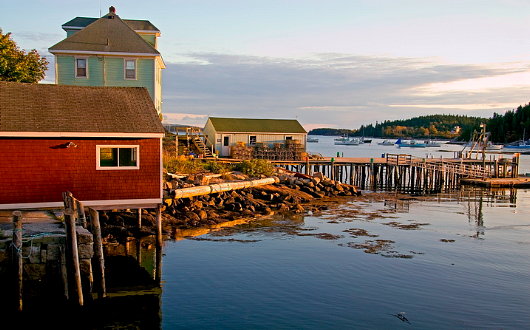Cusack’s Diary
About Andrew Cusack
 Writer, web designer, etc.; born in New York; educated in Argentina, Scotland, and South Africa; now based in London.
Writer, web designer, etc.; born in New York; educated in Argentina, Scotland, and South Africa; now based in London. read more
News
Blogs
Reviews & Periodicals
Arts & Design
World
France
Mitteleuropa
Knickerbockers
Argentina
The Levant
Africa
Cape of Good Hope
Netherlands
Scandinavia
Québec
India
Muscovy
Germany
Academica
The Mornings of the World
THERE IS A CERTAIN bizarre and unreasonable attraction about the existentialists — as if amidst all the ridiculous and fatuous statements they made, there was here and there a phrase in which, while utterly inexplicable, one can nonetheless find some deep resonance. This is especially true of Camus, who (for me) is instantly the most convincing of that lot, and – perhaps because of that – the one most naturally separable from them.
Camus, I read somewhere, had a particular phrase or concept or perhaps even idée fixe that constantly resurfaced in several of his works: the morning of the world, or les matins du monde (as Camus rendered it in plural). (more…)
Cocktail, Anyone?
A journey into the drinks cabinet
The multifaceted realm of blogging has been penetrated by a friend and occasional drinking partner of mine. Known only as the Sybarite, he brings us a few thoughts on the inhabitants of the drinks cabinet. I thought I’d share his thoughts with you, as well as adding a dash of mine own into the mix. (more…)
Diary
HOW MANY COUNTRIES have you been to? As for myself, not many, perhaps a dozen, although I’ll concede that that dozen is spread over four continents. I know people who have been to two or three times as many countries as I have, particularly if they’ve travelled through the Continent, where you can notch up several in a single day. My travel plans tend to be those of saturation rather than spread: I visit places and start relationships with them and then keep coming back.
And how do you decide that you’ve “been” to a country? There are various methods of determination. (more…)
Autumn by the Hudson

Some consider winter the time of death and desolation but I disagree. Winter for me is the incubation, the child in the womb, the seed beneath the soil waiting for the moment to sprout. Autumn, rather, is the time of melancholy and retrospection. Most of the trees here in New York are now bare, but before the leaves fell our friend the Brooklyn-based graphic & web designer Emily E. Owen (website here) caught these photographs of New York in the brilliant crepuscular light. The views are from Fort Tryon Park at the very top of the isle of Manhattan. (more…)
Scotland in Snowfall
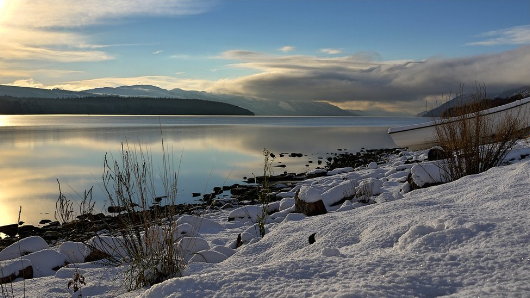
Scotland has been enveloped in snowfall, and the BBC has put a photo gallery up of reader-submitted images of the recent precipitation. The In Pictures feature of BBC News Online’s Scottish section has for years been one of my favourite parts of the website, offering a new series of photographs every week varying from the startling to the quotidian. Above is Michael Rennie’s view of a rather peaceful-looking Loch Ness. (more…)
Saints in Heaven, Pray for Us!

There are events occurring very soon which have massive life-changing potential for your humble & obedient scribe, and which could go quite horribly wrong or astoundingly well.
I absolutely implore you to pray to all the saints in Heaven, and especially to whichever Guardian Angels may be relevant, to combine, conspire, pray, and intercede for my special intention.
Thank you in advance for all your prayers, and I will keep you all in my prayers as well.
Brown 26, Yale 14
B.U.R.F.C. 1st XV v. Y.U.R.F.C. 1st XV

I never paid much attention to rugby before I lived in South Africa, where it is inescapable, especially since I was studying at Stellenbosch, which the rugby-est of rugby universities. After becoming a rugby spectator you cannot go back to watching American football, which, with its stopping and starting, suddenly has the feeling of being a demented child’s game. And so, across the Connecticut border to trusty old New Haven, to join some friends and fellow club-members for some Saturday afternoon rugby and revelry, with champagne, whiskey, and home-brewed porter on offer. (more…)
Popping in to the Yale Daily News
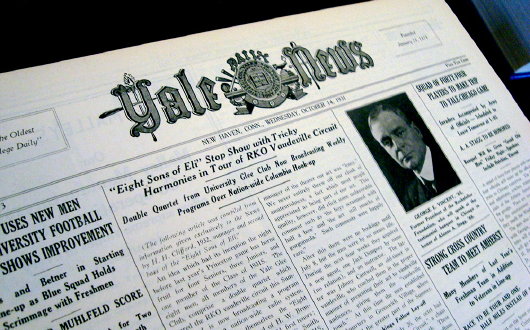
With a bit of time to spare between the rugby match and dinner, we discovered a friend of ours was exploring the newly renovated headquarters of the Yale Daily News and were invited to join in. The handsome gothic structure is now overshadowed by an ugly extension to the previously ugly Yale School of Architecture, widely believed to be the ugliest building in town. Henry Luce paid for the YDN building out of his own pocket in memory of his Yale classmate Briton Hadden, who died just 31 years old. The place went up in 1932 and underwent a multi-million-dollar renovation over the summer, and the place was looking good. (more…)
Maine
Well, your humble and obedient scribe is retreating to the coast of Maine, whence the defeated loyal men of Berwick fled after suffering defeat at the hands of the wretched Cromwell in the Battle of Dunbar. I am bringing a few friends along, including Mssrs. Trollope, Goethe, Burns, Chesterton, Balzac, von Rezzori, and a Ms. Undset (I am finally more than two-thirds of the way through Kristin Lavransdatter). There may also be a corgi or two. Internet connectivity very sketchy in those parts, though I will see if I can send a pigeon back to Hogarth if any news. (Doubtful it would do any good; the last e-mail I had him send he instinctively translated into dots and dashes — he does remind me of Uncle Otto sometimes).
So I bid you farewell, and you can expect my return in a fortnight’s time, invigorated anew by the salty breeze.
Martin Gardner
IT’S ONE 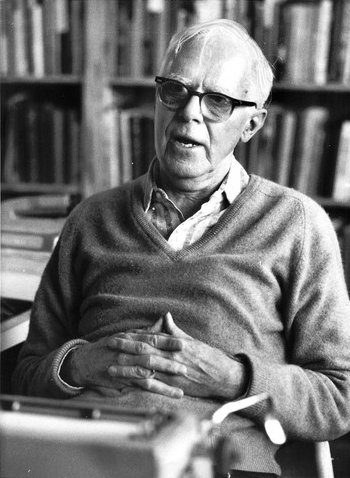 OF those strange things that I always automatically assume that anyone I know or have had dealings with cannot, by any stretch of the mind, be considered famous or well-known. The falseness of this assumption was made apparent to me when I picked up this week’s Economist after it arrived through the mail slot. As usual, there were a number of fascinating and well-informed articles, on the airlines of the Gulf, on the Colombian election, a special report on South Africa, and more. But then I finally reached the end pages and read the full page obituary of “Martin Gardner, man of letters and numbers,” who died on May 22nd at 95 years of age.
OF those strange things that I always automatically assume that anyone I know or have had dealings with cannot, by any stretch of the mind, be considered famous or well-known. The falseness of this assumption was made apparent to me when I picked up this week’s Economist after it arrived through the mail slot. As usual, there were a number of fascinating and well-informed articles, on the airlines of the Gulf, on the Colombian election, a special report on South Africa, and more. But then I finally reached the end pages and read the full page obituary of “Martin Gardner, man of letters and numbers,” who died on May 22nd at 95 years of age.
I never met Mr. Gardner but interacted with him several times during my New Criterion days by phone, and good old-fashioned post. He was a regular though not a frequent contributor to the magazine and was singular in that he was the only writer with whom the editor did not have the option of contacting via that nebulous mystery called the world-wide web. It was often, I confess, a source of some frustration that one would have all ones eggs in a row regarding pieces edited and signed off, and then there’d be something to do with Martin Gardner’s work and one would think “Blast! You mean I’ve got to stick this in an envelope to get the final OK?” Of course, when The New Criterion was founded, there was no internet, so there was a time when the whole magazine — indeed when every magazine — was put together via what I called the Martin Gardner method.
This aspect notwithstanding, it was always a pleasure working with Mr. Gardner, who was unfailingly polite over the phone when he would call in with his changes to our edits. It’s one of those inevitable aspects of death that one often discovers more interesting facts about the deceased than one ever knew while he was alive. In Martin Gardner’s case, it’s that this science maven published a number of annotated editions of works by G. K. Chesterton.
Roger Kimball writes of his last contact with Martin Gardner just a short time ago:
I wrote to tell him about the coincidence that a good friend now occupies the house he lived in for decades on Euclid Avenue (how’s that for an appropriate name?) in Hastings-on-Hudson, New York. I discovered this quite by accident. My wife and I were having dinner with a few other people at our friends’ house. I can’t remember Gardner’s name came up, but when it did I mentioned that he had lived for many years in Hastings-on-Hudson. “Yes,” said my friend, “and he lived in this very house.” One of the other couples present also knew Gardner. They recalled the time he invited them, shortly after they had moved to the neighborhood, to his house for drinks. Would it be alright if they brought their young children along, since no baby-sitter was available? Of course, nothing could be more agreeable! They arrived and Gardner proceeded to entertain the children with magic tricks for two hours.
My favourite story, however, is that he once wrote a devastating review of one of his own books and got it published under a pseudonym in the New York Review of Books. While he was a noted contributor to numerous sceptical reviews, he did come to a belief in God late in his life. “His declaration,” The Economist writes, “of this belief caused, he admitted, profound shock to those who knew him only as a sceptic. But there was too much playfulness in Mr Gardner to make him yield entirely to reason. His faith, he said, was based on an “emotional turning of the will”, unsupported by logic or science. It was his way, perhaps, of recognising that mind and man are not synonyms.”
Requiescat in pace.
In a Stellenbosch Garden
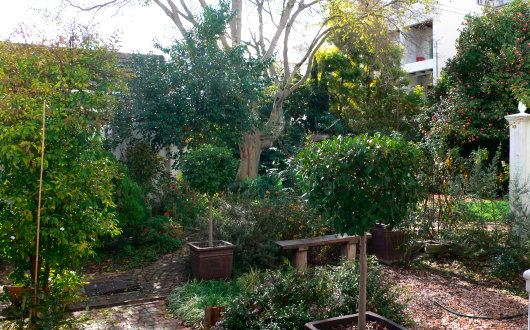
One of the pleasures of South Africa is that it is so conducive to the leafy things in life. Plants grow most of the year, so even while many of the trees may be bare, there is usually enough greenery about to keep things merry, as supported by the evidence of these shots of the garden of the little place in Stellenbosch where I used to live. Of course, this amenity to growth has its faults as well. Oak trees grow too quickly in this part of the world, leaving their wood too loose and unsuitable for use in barrelling. Wine- and brandy-makers must import their barrels from abroad, adding an irritating expense. Regardless of this incidental deficiency, South Africa still manages to produce some top-notch wines. (more…)
120 East End Avenue

BACK IN MY school days, there was a girl in this building who threw rather good parties. Even at a decent event, however, one or two are bound to show up that really ought not to have done so, and at one of these parties at 120 East End Avenue just such a person got wildly drunk, seized a half-full bottle of vodka (Smirnoff, I believe) and launched it out the window. As luck would have it, gravity deposited the vessel many floors below, landing right on top of windshield of the doorman who happened to be serving that night.
Now, doorman relations are important in Manhattan (as apartment building owners are quite aware). When Mr. & Mrs. Smith jaunt off to Paris, leaving Jenny at home, and some twenty-odd young lads & lasses show up requesting admittance to the Smiths’ place — the doorman knows all and sees all, and one must ensure that, upon Mom & Pop’s return, he doesn’t tell all. (more…)
Engelsman se Graf
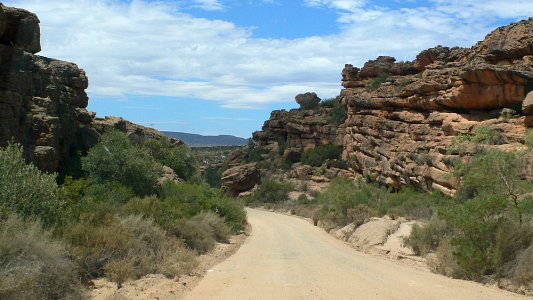
It was just a dot and a name on the map on our way to Wupperthal — Englishman’s Grave, “Hmmm… I wonder what that could be”. The Cederberg mountains have many charms, and of course any one who drinks as much rooibos tea as I must be intrigued to see the only place in the world where it is commercially grown. Leopards, caracals, and bonteboks guard these hills, and of course our friend the dassie (previously seen here) is known to wander around its rocks. (more…)
Diaz Point
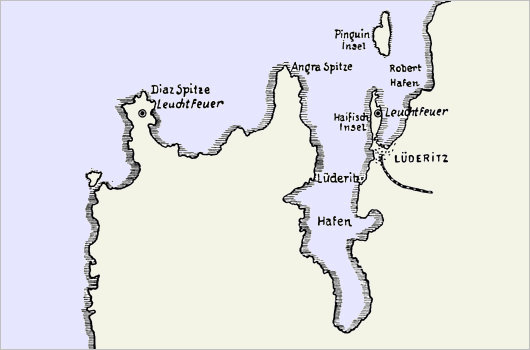
You drive to the end of the world, turn left, and continue. That’s the way to get to Diaz Point. Namibia’s coastline is supposed to be the least hospitable on the planet, with desert meeting salty ocean with naught in between. Staying the night at Seeheim, an agglomeration of half a dozen houses nearby a stone castle hotel, we woke early and drove the 200+ miles west through the arid rocky desert. The experience is made all the more interesting for the 16,000-square-mile “Restricted Diamond Zone” one drives on the northern periphery of. Namibia’s diamonds are primarily alluvial deposits, meaning they rest on ancient river beds, sitting on the soil or resting just a few feet below. The forbidden territory’s guards are believed to have a policy of shooting first and asking questions later. There are over sixty countries in the world smaller than the Sperregebiet (forbidden area), as the Restricted Diamond Zone is colloquially known.
Eventually — passing through the area inhabited by the wild horses of the Namib, descendants of German cavalry horses and farm animals variously escaped or set free — you arrive at the town of Lüderitz on the Atlantic coast. Besides its German street names (Zeppelinstraße, not to mention Bismarck, Bahnhof, Moltke), the town’s architecture is a curious Teutonic colonial, reinvented for the almost-tropical locale. From one or two of the local businesses, one could easily imagine a slightly overweight German in a linen suit and panama hat, with an eye-patch as well as a cane for his limp, ordering around the natives crudely while engaged in some nefarious criminal enterprise or campaign of sabotage.
But for Diaz Point, you go to Lüderitz, turn left, and go further still. Driving south from the colonial town, you encounter a barren, rocky, and utterly colourless landscape, the grey tones of which immediately bring to mind the surface of the Moon. Am I still on Earth? Only the blue sky and the occasional appearance of vegetation remind you that you’re still on the third planet from the Sun. (more…)
A precursor of Springtime
Having had more snow than usual this winter, we have been blessed with a sudden warm spell that makes one appreciate spring’s coming is not far. While winter days are best spent indoors beside the hearth, today’s temperature made some significant flirtations towards 60°, thus requiring a venture outdoors. Bescarved and betweeded, I tromped through the fields, greeted by birds singing an unusual tune, perhaps surprised by the lack of late winter’s usual frigidity. Viewing the leafless trees and the lifeless vegetation there is little doubt winter is still definitely upon us. But at least some of our avian friends remain amongst us.
Over two-hundred species of bird, the enthusiasts tell me, have been sighted in the fields and marshes through which I tromp. Most famously, twenty years ago a Wood Sandpiper — Tringa glareola — found its way to these parts. The Wood Sandpiper breeds in Scandinavia and spends northern winters in southern Africa or Australia (a not disagreeable routine, one would suppose). The 1990 Wood Sandpiper of Westchester whetted the whistles of birdwatchers (themselves a curious species) up and down the Eastern seabord. (more…)
An Evening at the Travellers Club
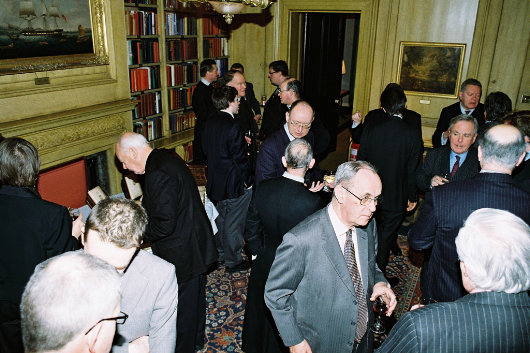
Photo: © Zygmunt von Sikorski-Mazur
TO CLUBLAND, THEN, for a book launch. Of course the secret about book launches is that they are often enough a convenient excuse to assemble a whole troop of interesting characters together, with the introduction of a newly published volume occupying a secondary (while nonetheless prominent) role. In this, our esteemed hosts Stephen Klimczuk and Gerald Warner of Craigenmaddie, authors of Secret Places, Hidden Sanctuaries, exceeded themselves. For me, the evening actually began not in the Travellers but just around the corner in the Carlton Club. Rafe Heydel Mankoo had suggested meeting up there for a drink or two or three before proceeding thencefrom toward the book launch at the Travellers. Pottering over from Victoria, I arrived at the Carlton and was guided towards the members’ bar where I easily found Rafe nursing a drink beside the hearth.
The usual updates were exchanged of various goings-on that had taken place since our last combination in August. Conversation naturally turned to Canada (where Rafe was raised) and shifted to New Zealand just before we greeted the arrival of Guy Stair Sainty. Guy I first met just four years ago while enjoying a pilgrimage to Rome. We happened to stumble upon him in the Piazza San Pietro (as one does with an odd frequency in the Eternal City), and, as it was my birthday, we invited him to join us for some champagne at this little place that overlooks the square. Guy was then in the midst of completing for Burke’s Peerage the massive, two-volume World Orders of Knighthood & Merit, or “WOKM”, which loomed restively on a nearby table as we sipped our drinks in the Morning Room. (more…)
The Wolseley
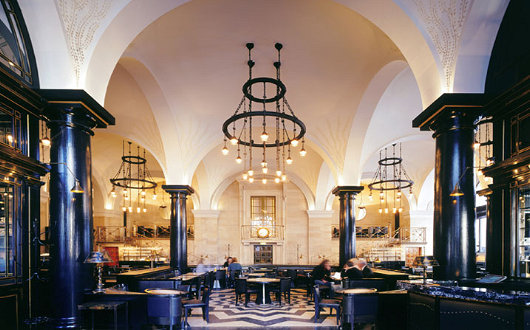
Our itineraries only had us both in London for less than twenty-four hours. Sam, now lawyering in his native Lancashire — “Recusant country, Cusack, you’d love it.” — was down in London for a party on Friday night. “How about a coffee Saturday morning before I head back up north?” Why not. “It’d have to be early though.” Blast. How early? “Say… 10 o’clock?” Well, that’s not so bad is it! Where to meet? “The Wolseley, next to the Ritz.” Never heard of it, but Sam must know what he’s up to.
Here, I have to admit that I usually hate public places devoted to the consumption of food. Restaurants irritate me and I infinitely prefer the dinner party to the restaurant appointment. Even the places I like, I actually despise in one way or another. But the Wolseley failed to irritate me in the slightest, which earns it very high marks indeed in the Grand Book of Cusack. The staff are friendly but suitably removed, the coffee is excellent, and the food tasty with portions just the right size. On Sam’s recommendation I tried the Wiener Kaffee, and ordered French toast for myself, Sam taking pancakes. Everything was just as it should be, and without any fuss. What better praise could one give such an establishment? (more…)
Dinner at Chiara’s
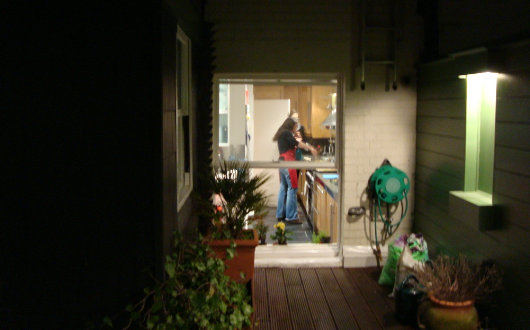
“Chiara,” I asked, “How will you ever know whether your friends are truly your friends or if they really just love your pumpkin risotto?” “You know,” she replied in her thick Italian accent, “this is a serious problem!” The possibility of never cooking pumpkin risotto again was mooted, but wholeheartedly condemned by all in attendance. The very thought was an affront to our salivating taste buds. (more…)
Kidnap and Rescue
Followers of Seraphic’s blog will doubtless have read of my Caledonian misadventure, whereby I was kidnapped by the inhabitants of an historic house in East Lothian. This update was followed by the Sexagesima Social Report, detailing our Sunday Mass, followed by the Cup of Tea of Peace, followed by the Gin & Tonic of Fortitude. Pleasant as my enforced captivity was, various duties in London obliged me to cooperate with the successful rescue effort made, curiously, by Royal Dutch Commandos.
Further ruminations on my Britannic sojourn are forthcoming.
Scotland
Written and illustrated by Andrew Cusack (at 7 years of age)
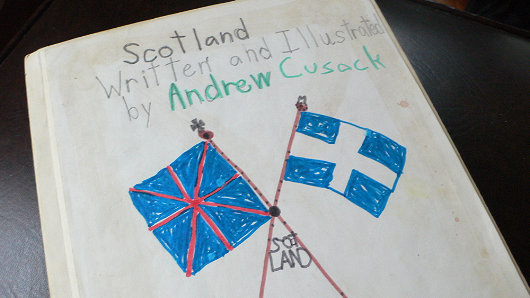
Were I to review this book, I would say it is riddled with inaccuracies and depicts a stereotypical Hollywood version of Scotland far-removed from reality. But then, it was written in 1991 by a seven-year-old (yours truly), which is already eighteen years ago now. The ultimate schoolboy error is that I was apparently incapable at age 7 of producing a vexillologically accurate reproduction of the Saltire. My incorrect version of the Scottish appears like the old Greek flag, a white cross extended across a blue field. (See the correct flag here). (more…)
Search
Instagram: @andcusack
Click here for my Instagram photos.Most Recent Posts
- Sag Harbor Cinema March 26, 2025
- Teutonic Takeover March 10, 2025
- Katalin Bánffy-Jelen, R.I.P. March 3, 2025
- Substack Cusackiensis March 3, 2025
- In the Courts of the Lord February 13, 2025
Most Recent Comments
Book Wishlist
Monthly Archives
Categories

